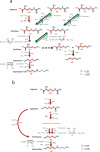Intestinal luminal putrescine is produced by collective biosynthetic pathways of the commensal microbiome
- PMID: 30183487
- PMCID: PMC6546329
- DOI: 10.1080/19490976.2018.1494466
Intestinal luminal putrescine is produced by collective biosynthetic pathways of the commensal microbiome
Abstract
The intestinal microbiome produces various metabolites that may harm or benefit the host. However, the production pathways of these metabolites have not been well characterised. The polyamines putrescine and spermidine required for physiological process are also produced by intestinal microbiome. The production and release of these polyamines by microbiome are poorly understood, though we have confirmed that intestinal bacteria produced putrescine from arginine. In this study, we characterised polyamine synthesis by analysing the collective metabolic functions of the intestinal microbiome. In particular, we analysed polyamines and their intermediates in faecal cultures, as well as the colonic contents of rats injected with isotope-labelled arginine through a colon catheter, using mass spectrometry. Isotope-labelled putrescine was detected in faecal cultures and colonic contents of rats injected with isotope-labelled arginine. Putrescine is produced through multiple pathways, and its extracellular intermediates are exchanged between bacterial species. Additionally, we demonstrated that the collective metabolic pathway depends on a complex exchange of metabolites released into the colonic lumen. This study demonstrates the existence of putrescine biosynthetic pathways based on the collective metabolic functions of the intestinal microbial community. Our findings provide knowledge to manipulate the levels of intestinal microbial products, including polyamines, that may modulate host health.
Keywords: Intestinal microbiome; Polyamines; arginine degradation; metabolomics; stable isotope.
Figures




Similar articles
-
Comprehensive analysis of polyamine transport and biosynthesis in the dominant human gut bacteria: Potential presence of novel polyamine metabolism and transport genes.Int J Biochem Cell Biol. 2017 Dec;93:52-61. doi: 10.1016/j.biocel.2017.10.015. Epub 2017 Nov 2. Int J Biochem Cell Biol. 2017. PMID: 29102547
-
Prevention of Atherosclerosis by the Induction of Microbial Polyamine Production in the Intestinal Lumen.Biol Pharm Bull. 2020;43(2):221-229. doi: 10.1248/bpb.b19-00855. Biol Pharm Bull. 2020. PMID: 32009110 Review.
-
Upregulation of colonic luminal polyamines produced by intestinal microbiota delays senescence in mice.Sci Rep. 2014 Apr 1;4:4548. doi: 10.1038/srep04548. Sci Rep. 2014. PMID: 24686447 Free PMC article.
-
Uncovering de novo polyamine biosynthesis in the gut microbiome and its alteration in inflammatory bowel disease.Gut Microbes. 2025 Dec;17(1):2464225. doi: 10.1080/19490976.2025.2464225. Epub 2025 Feb 9. Gut Microbes. 2025. PMID: 39924644 Free PMC article.
-
Polyamine metabolism and transport in gut microbes.Biosci Biotechnol Biochem. 2022 Jul 22;86(8):957-966. doi: 10.1093/bbb/zbac080. Biosci Biotechnol Biochem. 2022. PMID: 35648468 Review.
Cited by
-
The Roles of Polyamines in Intestinal Development and Function in Piglets.Animals (Basel). 2024 Apr 19;14(8):1228. doi: 10.3390/ani14081228. Animals (Basel). 2024. PMID: 38672376 Free PMC article. Review.
-
Over supplementation with vitamin B12 alters microbe-host interactions in the gut leading to accelerated Citrobacter rodentium colonization and pathogenesis in mice.Microbiome. 2023 Feb 3;11(1):21. doi: 10.1186/s40168-023-01461-w. Microbiome. 2023. PMID: 36737826 Free PMC article.
-
Human Adult Microbiota in a Static Colon Model: AhR Transcriptional Activity at the Crossroads of Host-Microbe Interaction.Foods. 2022 Jun 30;11(13):1946. doi: 10.3390/foods11131946. Foods. 2022. PMID: 35804761 Free PMC article.
-
The role of colonic microbiota amino acid metabolism in gut health regulation.Cell Insight. 2025 Jan 10;4(2):100227. doi: 10.1016/j.cellin.2025.100227. eCollection 2025 Apr. Cell Insight. 2025. PMID: 39926315 Free PMC article. Review.
-
Intestinal metabolites in colitis-associated carcinogenesis: Building a bridge between host and microbiome.Chin Med J (Engl). 2025 Aug 20;138(16):1961-1972. doi: 10.1097/CM9.0000000000003430. Epub 2025 Apr 27. Chin Med J (Engl). 2025. PMID: 40287783 Free PMC article. Review.
References
-
- Gibson GR, Roberfroid MB.. Dietary modulation of the human colonic microbiota: introducing the concept of prebiotics. J Nutr. 1995;125:1401–1412. - PubMed
-
- Martens JH, Barg H, Warren MJ, Jahn D. Microbial production of vitamin B12. Appl Microbiol Biotechnol. 2002;58:275–285. - PubMed
-
- Lee WJ, Hase K. Gut microbiota-generated metabolites in animal health and disease. Nat Chem Biol. 2014;10:416–424. - PubMed
MeSH terms
Substances
LinkOut - more resources
Full Text Sources
Other Literature Sources
